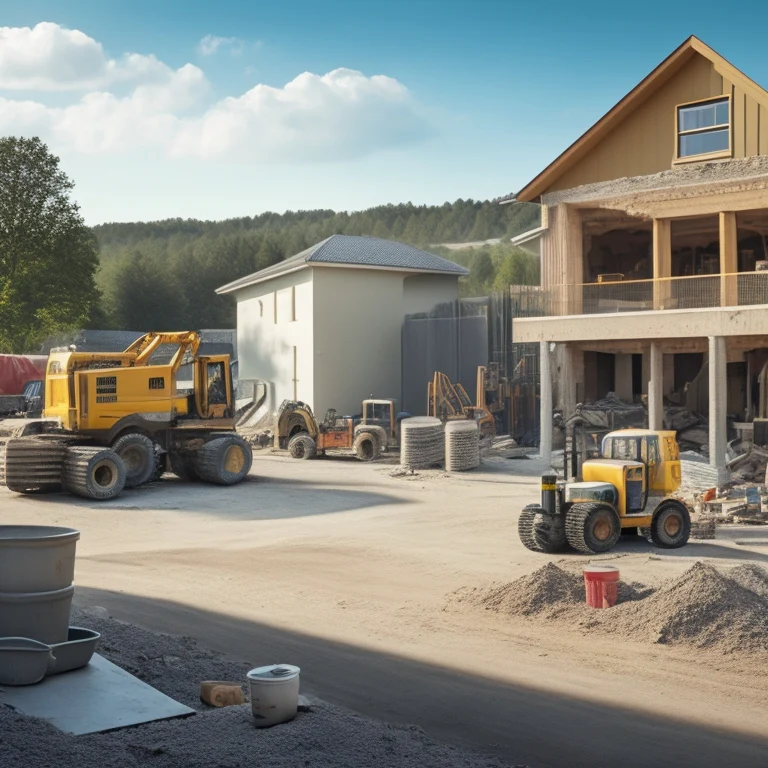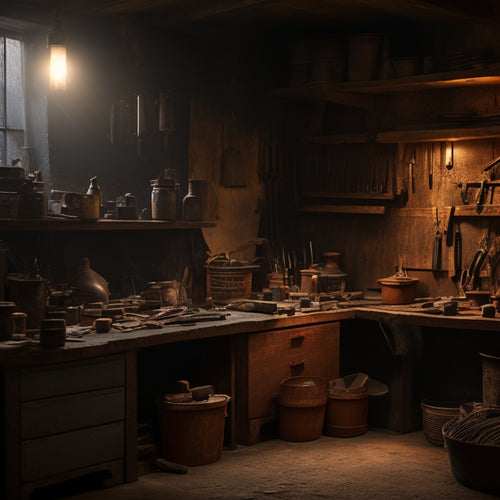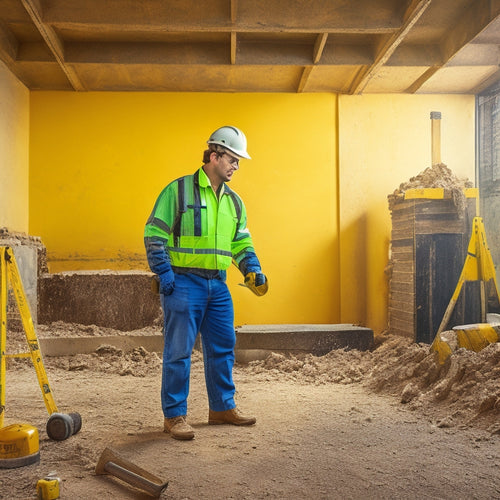
10 Best Concrete Mixers for Home Renovation Projects
Share
When tackling a home renovation project, you'll need a reliable concrete mixer to get the job done efficiently. With various types of mixers available, it's crucial to evaluate your specific needs, from electric and gas-powered options to high-speed and low-noise designs. Assess features like ease of use, multiple speed controls, and versatility to find the right fit. Your budget will also play a role, as you weigh affordable options against heavy-duty mixers for larger projects. By understanding these factors, you'll be well on your way to selecting the perfect concrete mixer for your renovation project, and uncovering the best tools to achieve professional-grade results.
Key Takeaways
• Consider the type of mixer needed: electric, gas-powered, high-speed, low-noise, or heavy-duty, based on project size and requirements.
• Look for ease of use features like adjustable handles, soft-start functionality, and clear control panels to reduce fatigue and improve mixing efficiency.
• Multiple speed controls and versatile mixing equipment can fine-tune mixing processes and enhance consistency throughout the batch.
• Budget considerations should include affordable mixer options, DIY savings strategies, and cost-effective mixing tools to optimize concrete usage and reduce waste.
• Prioritize performance and efficiency by selecting mixers with high capacity, ergonomic designs, and easy maintenance access to minimize downtime.
Top Rated Mixers for Small Projects
When tackling small-scale home renovation projects, you'll want to contemplate investing in a reliable concrete mixer that can efficiently handle batches of 1-2 cubic feet, such as the top-rated models specifically designed for small projects.
These compact designs are ideal for mixing small quantities of concrete, making them perfect for DIY projects, patio renovations, or repairing cracks in your driveway.
Look for mixers with user-friendly features, such as easy-to-operate controls, tilting drums, and robust steel frames that guarantee stability and durability.
Top-rated models also typically come with adjustable handles and wheels, allowing for effortless transportation and maneuverability.
Additionally, consider mixers with rust-resistant coatings and protective covers to extend their lifespan.
Electric Concrete Mixers for Home
When selecting an electric concrete mixer for your home renovation project, you'll want to take into account three key factors.
You'll need to think about the power and portability of the mixer, as well as the mixing capacity options it offers.
Power and Portability Matters
You'll likely find that electric concrete mixers, which are specifically designed for home use, offer an ideal balance of power and portability. When it comes to power sources, you'll want to take into account the wattage and amperage ratings to guarantee the mixer can handle your project's demands. Typically, electric mixers for home use range from 1/2 to 1 horsepower, with some models featuring variable speed controls for added precision.
In addition to power, weight considerations are essential for portability. You'll want a mixer that's light enough to move around your workspace, but sturdy enough to withstand the rigors of mixing. Look for mixers with durable frames, ergonomic handles, and compact designs that make them easy to maneuver.
Here are some key factors to take into account when evaluating the power and portability of an electric concrete mixer:
-
Motor power: Look for a mixer with a reliable, high-torque motor that can handle heavy loads.
-
Weight and size: Evaluate a mixer that's lightweight yet durable, with a compact design for easy storage.
-
Ergonomic design: Opt for a mixer with comfortable, ergonomic handles and a balanced design for reduced fatigue.
- Cord length and storage: Guarantee the mixer has a sufficient cord length and convenient storage options for the cord and other accessories.
Mixing Capacity Options
With the power and portability of your electric concrete mixer established, it's time to contemplate the mixing capacity that will best suit your home renovation project. The mixing capacity of your concrete mixer determines how much concrete you can mix in one batch, which directly affects the efficiency of your project. You'll want to choose an ideal size that meets your specific needs.
Here's a breakdown of common mixing capacity options:
| Mixing Capacity | Batch Size | Suitable For |
|---|---|---|
| 1-2 cu. ft. | Small batches, DIY projects | Small to medium-sized renovation projects |
| 3-4 cu. ft. | Medium batches, small commercial projects | Medium-sized renovation projects, small commercial applications |
| 5-6 cu. ft. | Large batches, commercial projects | Large renovation projects, commercial applications |
When selecting a mixing capacity, consider the scope of your project, the size of your workspace, and the number of workers involved. A larger mixing capacity may seem appealing, but it may not be suitable for smaller projects or confined workspaces. On the other hand, a smaller mixing capacity may require more frequent batches, increasing project duration. By choosing the right mixing capacity, you'll make certain your project runs smoothly and efficiently.
Ease of Use Features
Electric concrete mixers for home renovation often feature ergonomic design elements and intuitive controls that simplify the mixing process, allowing you to focus on getting the job done efficiently.
As you evaluate different models, look for features that promote ease of use, such as:
-
Adjustable handles: Allowing you to customize the mixer to your comfort level and reduce fatigue.
-
Soft-start functionality: Gradually increasing the mixer's speed to prevent sudden jerks and loss of control.
-
Ergonomic grip design: Providing a comfortable hold that reduces strain on your hands and wrists.
- Clear and concise control panels: Ensuring you can easily monitor and adjust the mixing process.
These features are designed to make the mixing process more manageable, reducing the physical demands on you and allowing you to focus on achieving the perfect mix.
With user-friendly controls and an ergonomic design, you'll be able to work more efficiently and effectively, ensuring your home renovation project stays on track.
Budget Friendly Options for DIY
As you plan your DIY home renovation project, you're likely looking for ways to stay within budget.
You'll be happy to know that there are affordable mixer options available that won't break the bank.
Affordable Mixer Options
You can find budget-friendly concrete mixer options that cater specifically to DIY enthusiasts, offering a cost-effective solution for small to medium-sized projects. These mixers are designed to meet the needs of homeowners and DIYers who want to tackle renovation projects without breaking the bank.
When shopping for an affordable mixer, consider the following key factors to guarantee you get the right one for your project:
-
Motor power: A lower horsepower motor can be sufficient for small projects, but may not be suitable for larger ones.
-
Drum capacity: A smaller drum capacity can be more cost-effective, but may require more frequent mixing.
-
Material quality: Look for mixers with durable, rust-resistant materials that can withstand heavy use.
- Additional features: Consider mixers with features like adjustable handles, tilting drums, and built-in wheels for added convenience.
Remember to prioritize DIY mixer maintenance and mixer safety tips to guarantee your mixer lasts for multiple projects. Regular cleaning, lubrication, and inspection can help prevent breakdowns and guarantee safe operation.
DIY Savings Strategies
To maximize your DIY budget, consider implementing strategic cost-cutting measures that won't compromise the quality of your project, starting with mixer selection and extending to other aspects of your renovation.
By adopting smart budgeting tips, you can allocate your resources efficiently and make the most of your hard-earned money.
When it comes to DIY project management, planning is key. Create a detailed project timeline and identify areas where you can save time and money without sacrificing quality.
Consider repurposing materials, borrowing tools from friends, or scouring online marketplaces for second-hand deals.
Additionally, prioritize tasks that require professional expertise, and focus on DIY-friendly tasks that can be completed efficiently.
Cost-Effective Mixing Tools
Selecting the right concrete mixer for your DIY project can greatly impact your budget. Opting for cost-effective mixing tools can help you stay within your means without compromising on quality.
As a DIY enthusiast, you understand the importance of balancing cost and performance. When it comes to concrete mixing, you don't need to break the bank to achieve professional-grade results.
Here are some budget-friendly options to evaluate:
-
Manual mixers: Perfect for small to medium-sized projects, manual mixers are an affordable and effective solution.
-
Electric mixers with affordable accessories: Look for mixers with interchangeable paddles and drums to increase their versatility.
-
Mixing buckets with built-in handles: These buckets make it easy to mix and transport concrete without additional equipment.
- DIY mixing techniques: Develop your own mixing techniques to reduce waste and optimize your concrete usage.
High Capacity Mixers for Large Jobs
Large-scale home renovation projects require high-capacity mixers that can handle massive volumes of concrete, guaranteeing efficient and timely completion of the job. When you're dealing with massive concrete requirements, you need a mixer that can keep up with your demands.
High-capacity mixers are designed to maximize mixing efficiency, allowing you to complete large projects quickly and effectively. These mixers typically feature large drums, powerful motors, and advanced mixing systems that can handle heavy-duty concrete production.
When selecting a high-capacity mixer, prioritize safety features that protect you and your team from accidents. Look for mixers with protective guards, emergency stop systems, and ergonomic design that reduce operator fatigue.
Additionally, consider mixers with advanced mixing technologies that improve concrete quality and reduce waste. By investing in a high-capacity mixer with advanced safety features, you can guarantee a successful and profitable large-scale renovation project.
Portable Mixers for Easy Transport
You'll appreciate the convenience of portable mixers that can be easily moved around the job site, allowing you to mix concrete exactly where it's needed. These mixers are perfect for small to medium-sized projects, where mobility and flexibility are essential. With their lightweight designs, you can effortlessly transport them up and down stairs, or around tight corners, without breaking a sweat.
Here are some key benefits of portable mixers:
-
Easy to maneuver: Portable mixers are designed to be lightweight and compact, making them easy to move around the job site.
-
Compact storage: When not in use, portable mixers can be easily stored in small spaces, such as a garage or shed.
-
Versatile: Portable mixers can be used for a variety of projects, from small repairs to larger renovations.
- Cost-effective: Portable mixers are often more affordable than larger, heavy-duty mixers, making them a cost-effective option for smaller projects.
Gas Powered Mixers for Heavy Use
When you're tackling heavy-duty concrete mixing projects, you'll want a gas powered mixer that can keep up with your demands.
You'll appreciate the high-torque engine power that drives these machines, ensuring you can mix large quantities of concrete efficiently.
Additionally, the durable construction frames of these mixers are built to withstand the rigors of frequent use, providing you with a reliable workhorse for your renovation projects.
High-Torque Engine Power
Sixty-six percent of heavy-duty concrete mixing projects require gas-powered mixers with high-torque engine power to efficiently handle demanding tasks. When you're working on a large-scale renovation, you need a mixer that can keep up with your pace. That's why high-torque engine power is vital for gas-powered mixers. It guarantees that your mixer can handle heavy loads and mix thick concrete consistently.
To get the most out of your gas-powered mixer, look for the following key performance indicators:
-
Engine Performance: A high-performance engine with a robust power output (measured in horsepower or HP) guarantees that your mixer can handle demanding tasks.
-
Torque Specifications: Check the torque specifications (measured in foot-pounds or Nm) to confirm that your mixer can generate the necessary force to mix thick concrete.
-
RPM Range: A wide RPM range allows you to adjust the mixer's speed to suit different mixing tasks and materials.
- Fuel Efficiency: A fuel-efficient engine reduces operating costs and minimizes downtime.
Durable Construction Frames
With high-torque engine power guaranteeing efficient concrete mixing, a durable construction frame is equally essential for gas-powered mixers designed to withstand heavy use and harsh job site conditions.
You need a frame that can support the mixer's weight, withstand vibrations, and resist rust and corrosion. Look for frames made from heavy-duty materials like steel or aluminum, which provide excellent structural stability. A sturdy frame guarantees the mixer remains stable during operation, reducing the risk of accidents and improving overall performance.
When evaluating frame materials, consider the mixer's intended use and the environment it'll operate in. For instance, if you'll be working in coastal areas or humid environments, a rust-resistant coating or stainless steel frame may be necessary.
Additionally, check the frame's design and construction. A well-designed frame should have a low center of gravity, reducing the risk of tipping, and should allow for easy access to the mixer's components for maintenance and repair.
Mixers With High Speed Settings
You'll find that mixers with high speed settings can tackle demanding tasks, such as mixing heavy materials or large batches, with increased efficiency.
These machines are designed to provide high speed performance, allowing you to complete tasks quickly and effectively. With efficient mixing capabilities, you can achieve consistent results and reduce the risk of errors.
When shopping for a mixer with high speed settings, consider the following key features:
-
RPM range: Look for mixers with a high RPM range (typically above 500) for faster mixing times.
-
Motor power: A more powerful motor will provide the necessary torque for high speed mixing.
-
Gear system: A robust gear system will guarantee smooth and efficient transmission of power.
- Cooling system: A reliable cooling system will prevent overheating and extend the mixer's lifespan.
Low Noise Mixers for Residential Areas
When working on home renovation projects in residential areas, you need a mixer that won't disturb the peace, which is where low noise mixers come into play. These specialized mixers are designed to minimize disruptions, guaranteeing you can focus on getting the job done without upsetting your neighbors.
One key feature to look for in low noise mixers is quiet operation. This is typically achieved through advanced motor designs that reduce the overall decibel level of the mixer. Some models also incorporate sound-dampening materials to further minimize noise output.
Another important consideration is vibration reduction. Excessive vibration can't only contribute to noise but also affect the mixer's performance and durability. Look for mixers with advanced vibration-reducing technologies, such as rubber mounts or anti-vibration feet, to guarantee a smoother operation.
Mixers With Multiple Speed Controls
Operating a mixer with multiple speed controls allows you to fine-tune your mixing process, adjusting to the specific requirements of your concrete blend and guaranteeing ideal results. With a variable speed mixer, you can optimize the mixing process for different types of concrete, aggregates, and additives. This enhanced control enables you to achieve the perfect mix every time.
Here are some benefits of mixers with multiple speed controls:
-
Improved consistency: By adjusting the speed to suit the specific mixture, you can guarantee a consistent mix throughout the batch.
-
Reduced wear and tear: Variable speed mixers allow you to operate at lower speeds when necessary, reducing wear on the motor and extending its lifespan.
-
Increased flexibility: With multiple speed controls, you can tackle a wide range of mixing tasks, from thick, heavy mixes to thin, delicate ones.
- Better material handling: By controlling the speed, you can handle sensitive materials like fibers or admixtures with precision, guaranteeing they're evenly distributed throughout the mix.
When choosing a mixer with multiple speed controls, look for features like digital displays, soft-start functionality, and overload protection to guarantee safe and efficient operation.
Heavy Duty Mixers for Contractors
As a contractor, you know that tackling large-scale projects demands heavy-duty mixers that can keep up with your workload. Contractors who regularly handle large-scale projects require heavy-duty mixers that can withstand the rigors of frequent use and deliver high-volume output with precision and reliability.
When evaluating heavy-duty mixers, you'll want to examine models that prioritize heavy-duty performance. Look for mixers with robust motors, sturdy frames, and high-capacity drums that can handle bulky aggregates and high-viscosity materials. These features will enable you to tackle demanding projects with confidence, knowing your mixer can handle the load.
Contractor preferences often lean towards mixers with advanced features, such as adjustable mixing speeds, ergonomic design, and easy maintenance access. These features streamline your workflow, reduce fatigue, and minimize downtime.
Frequently Asked Questions
What Safety Precautions Should I Take When Operating a Concrete Mixer?
When operating a concrete mixer, you'll want to prioritize safety above all else.
Start by donning personal protective gear like gloves, safety glasses, and a dust mask to shield yourself from flying debris and airborne particles.
Confirm a stable mixer operation by checking the machine's balance and stability before use.
Keep loose clothing and long hair tied back, and avoid wearing jewelry that could get caught in the mixer's moving parts.
Can I Mix Other Materials Besides Concrete in a Mixer?
You're wondering if your mixer can handle alternative materials beyond concrete. The answer is yes, but with caveats.
Check your mixer's specifications to verify it can handle the new material's density and volume. Some mixers offer impressive versatility, allowing you to mix mortar, plaster, or even fireproofing materials.
However, be cautious not to exceed the recommended capacity or compromise the mixer's integrity. Always follow the manufacturer's guidelines to guarantee safe and effective mixing of your chosen material.
How Often Should I Clean and Maintain My Concrete Mixer?
As you wrap up each mixing session, remember: a clean mixer is a happy mixer!
You should clean your concrete mixer after every use, and perform deep maintenance every 3-6 months.
Check for rust, lubricate moving parts, and inspect electrical components.
A well-maintained mixer guarantees consistent results and extends its lifespan.
Set a schedule and stick to it – your mixer will thank you!
Are Concrete Mixers Suitable for Mixing Small Batches of Mortar?
When it comes to mixing small batches of mortar, you'll want to guarantee your mixer can handle the task.
Check the mixer capacity to see if it's suitable for the small batches you need.
You'll also want to take into account the mortar consistency, as it can be tricky to get right in small quantities.
If your mixer can handle the capacity and you can achieve the right consistency, then yes, it's suitable for mixing small batches of mortar.
Can I Use a Concrete Mixer for Mixing and Transporting Concrete Simultaneously?
As you're about to begin a medieval-style construction quest, you wonder if your trusty concrete mixer can handle mixing and transporting concrete simultaneously.
The answer is, it depends on the mixer's design and your transportation techniques. If you're using a mixer with a tilting or reversing drum, you might be able to mix and transport small batches efficiently.
However, this can compromise mixing efficiency and increase the risk of segregation. It's generally recommended to focus on one task at a time to guarantee the best results.
Conclusion
You've got the concrete mixer that's right for your home renovation project.
Like a conductor leading an orchestra, you'll harmoniously blend cement, sand, and water to create a solid foundation.
With the right mixer, your project's tempo will quicken, and you'll be on track to finish on time and within budget.
Now, get mixing and watch your project come together like a masterpiece!
Related Posts
-

Top Tools for DIY Home Renovation Plastering Success
To achieve DIY home renovation plastering success, you'll need a range of essential tools. Start with hand tools like...
-

Why Invest in Quality Plastering Tools for Renovation
When renovating, investing in quality plastering tools is essential for achieving professional-looking results and mi...
-

5 Vital Safety Tips for DIY Renovation Success
When tackling a DIY renovation, you'll need to prioritize safety above all else. Start by protecting yourself from fl...


